Capacity 80,242 | Broke ground November 30, 1972 Opened 10 October 1976 General contractor George A. Fuller | |
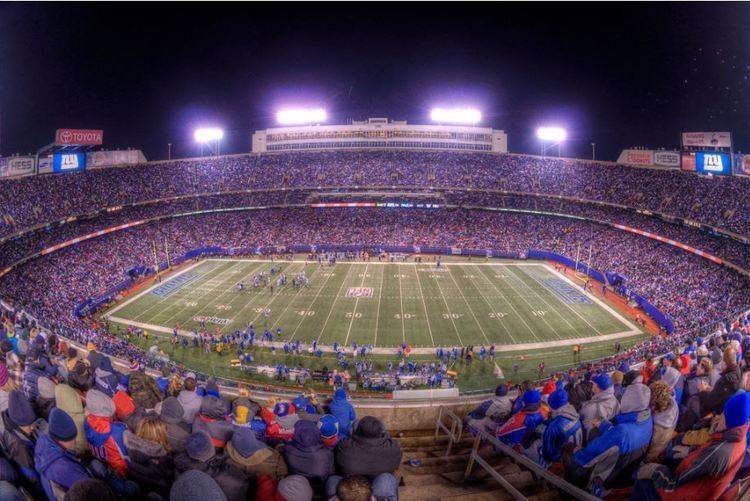 | ||
Closed January 3, 2010 (final game) Similar | ||
Grateful dead 6 17 91 giants stadium east rutherford nj
Giants Stadium was a stadium located in East Rutherford, New Jersey, in the Meadowlands Sports Complex. The venue was open from 1976 to 2010, and primarily hosted sporting events and concerts in its history. The maximum seating capacity was 80,242. The structure itself was 756 feet (230 m) long, 592 feet (180 m) wide and 144 feet (44 m) high from service level to the top of the seating bowl and 178 feet (54 m) high to the top of the south tower. The volume of the stadium was 64,500,000 cubic feet (1,830,000 m3). 13,500 tons of structural steel were used in the building process and 29,200 tons of concrete were poured. It was owned and operated by the New Jersey Sports and Exposition Authority (NJSEA).
Contents
- Grateful dead 6 17 91 giants stadium east rutherford nj
- History
- First year in business
- Other pro football teams that have used Giants Stadium
- College football games
- Soccer at Giants Stadium
- 1996 1997 Major League Soccer All Star Games
- 2000 Nike United States Cup matches
- 2005 CONCACAF Gold Cup matches
- 2007 CONCACAF Gold Cup matches
- Pope John Paul II at Giants Stadium
- Concerts
- Seating Capacity
- Demolition
- Changes and co tenants
- The Jimmy Hoffa urban legend
- Notable moments
- In popular culture
- References
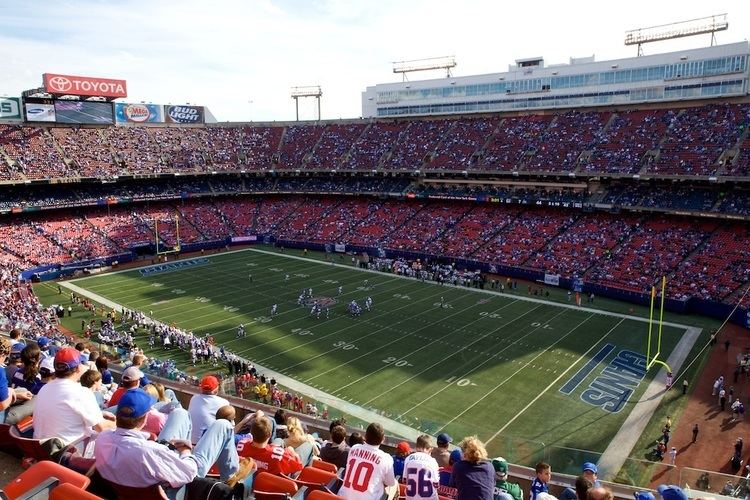
In the early 1970s the New York Giants, who at the time were sharing Yankee Stadium with the New York Yankees baseball team, began looking for a home of their own. The Giants struck a deal with the fledgling New Jersey Sports and Exposition Authority in 1971 and ground broke on the construction of the new facility in 1972. The 1972 season was the Giants' last full season in Yankee Stadium, as the ballpark was closed for a massive reconstruction following the end of the Yankees' season. Since their new stadium would take a significant amount of time to finish, and they could not use their home facility due to the construction, the Giants moved out of state and played in New Haven, Connecticut at the Yale Bowl early in the 1973 season. After spending two years in New Haven, the Giants would return to New York for one final season in 1975 and shared Shea Stadium in Flushing, Queens with the Yankees, New York Mets, and New York Jets. The Giants finally moved into their new home on October 10, 1976.
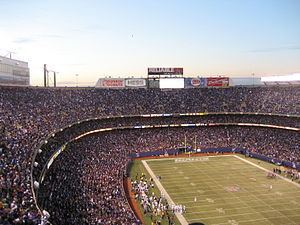
Eight years after Giants Stadium opened, it gained a second major tenant. The Jets' lease at Shea Stadium had expired at the end of the 1983 season and team owner Leon Hess was having trouble negotiating terms of a new lease to stay in Queens. The city of New York was unwilling to agree to his terms and Hess decided to move the Jets to the Meadowlands permanently (the team previously played a regular season game there in 1977). Their first game in Giants Stadium was on September 6, 1984. With the Jets now playing at the stadium, the grounds crew needed to find a way to set their games apart from Giants games and make them more inviting for their fans and eventually came up with a series of green and white banners and coverings that were hung over the field-level blue walls that circled the stadium and (later) the four entrance gates outside the stadium.
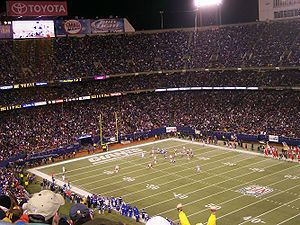
The sharing of the stadium by both the Giants and Jets enabled it to break a record that had long been held by Chicago's Wrigley Field. Entering the 2003 season, its 28th, Giants Stadium had played host to 364 NFL games, second only to the 365 played at Wrigley by the Chicago Bears in their 50 seasons there. The Giants' season opening game with the St. Louis Rams tied the record, and the following week the Jets' home opener against the Miami Dolphins broke it.
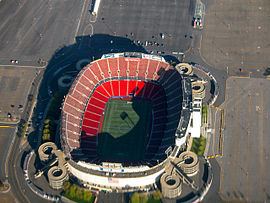
Giants Stadium was closed following the 2009 NFL season following the construction of what is now MetLife Stadium in the surrounding parking lot. The stadium's final event was the January 3, 2010 game featuring the Jets hosting the Cincinnati Bengals on Sunday Night Football. A month after the game, demolition of the structure began and was completed on August 10, 2010.
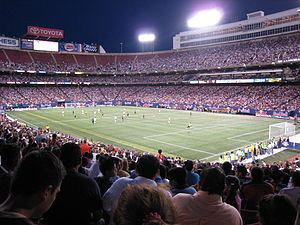
History
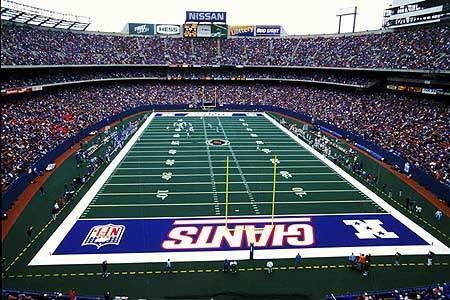
Giants Stadium was the first major league sporting venue in New Jersey (though the Brooklyn Dodgers had played seven home games at Roosevelt Stadium in Jersey City in 1956 & 1957), and its success, along with that of the Giants in the 1980s was a major impetus behind increased pride and enthusiasm among New Jersey residents.
First year in business
Giants Stadium opened on October 10, 1976, as 76,042 fans witnessed a loss by the Giants to the Dallas Cowboys. The Giants had played their first four games on the road that season. College football made its debut at Giants Stadium on October 23, 1976, with Rutgers University defeating Columbia 47–0 and extending their winning streak to 14 games.
The New York Giants played their season-opening home game in the stadium on September 18 of the 1977 season (a 20–17 win over the Washington Redskins).
Other pro football teams that have used Giants Stadium
Other professional football teams that have called Giants Stadium home over the years include the New Jersey Generals of the USFL; the New York/New Jersey Knights of the World League of American Football; the New York/New Jersey Hitmen of the XFL and the New York Sentinels (who played one game at the stadium in the United Football League's inaugural season). The 1985 USFL championship game which turned out to be the last USFL game played was held at Giants Stadium.
In the second week of the 2005 season, the New Orleans Saints used the stadium for a "home" game against the Giants because of extensive damage to the Louisiana Superdome after Hurricane Katrina. One end zone was painted in Saints colors, Saints banners were hung on the walls around the sidelines, and the Saints wore their home jerseys. The game was rescheduled to a Monday night with a special start time of 7:30 PM EDT, preceding the other scheduled game on Monday Night Football. The Giants were normally not visitors at Giants Stadium unless they were playing the Jets.
College football games
The stadium hosted college football games, including the Garden State Bowl from 1978 to 1981; the Kickoff Classic from 1983 to 2002; the New York Urban League Classic since 1981; a number of Rutgers homes games (including all their home games during the 1993 season); several Notre Dame–Navy and Notre Dame–Army games; and the Army–Navy Game on three occasions, most recently in 2002. Syracuse also played two home games at Giants Stadium during the 1979 season, against West Virginia and Penn State, while the Carrier Dome was under construction. Columbia also played some home games at Giants Stadium in 1983, due to construction at its home stadium. Temple, needing a home field due to a schedule conflict with Veterans Stadium in Philadelphia, used Giants Stadium as their home field versus Penn State in September 1996. Princeton also played one home game at Giants Stadium (against Yale) during the construction of Princeton's new stadium in 1997.
Soccer at Giants Stadium
The New York Cosmos of the North American Soccer League moved to Giants Stadium for the 1977 season and remained until the league folded in 1985. The NASL championship game Soccer Bowl '78 and Soccer Bowl '79 were held at Giants Stadium.
Seven games of the 1994 FIFA World Cup soccer tournament were held at Giants Stadium (including the Italy v Bulgaria semi-final), along with several games of the 1999 Women's World Cup.
In 2003, the SuperCoppa Italiana, an annual match pitting the winners of Serie A (Italy's top division) and the Coppa Italia (Italian Cup), was held in Giants Stadium instead of in Italy because both clubs involved (Juventus F.C. and A.C. Milan) were touring the United States late in the summer, when the event is normally scheduled.
In 2005, the stadium played host to several matches in the CONCACAF Gold Cup, including the final, which saw the USA defeat Panama, 3–1 in a penalty shootout after the sides played to a scoreless draw. It again held the final 4 years later for the CONCACAF Gold Cup which saw Mexico defeat the USA 5–0.
It has seen many European soccer tours in recent years, hosting games involving such major soccer clubs as Manchester United, Celtic, Chelsea, Liverpool, Barcelona and Rangers.
It also hosted England's 3–2 victory over Colombia on May 31, 2005.
The New York Red Bulls (formerly the New York/New Jersey MetroStars) of Major League Soccer played at the stadium for their first 14 seasons. They moved to the soccer-specific Red Bull Arena in nearby Harrison, New Jersey in 2010.
1996 & 1997 Major League Soccer All-Star Games
Giants Stadium hosted the first two Major League Soccer All-Star Game's ever played. The games were played in East vs. West format. The 1996 game was the first game of a doubleheader. That second game was between Brazilian soccer team and a team of FIFA All-Stars
1996:
1997:
2000 Nike United States Cup matches
United States won the 2000 Nike U.S. Cup in Game 1 of the doubleheader
2005 CONCACAF Gold Cup matches
Colombia, a CONMEBOL member, were invited to compete in the CONCACAF tournament, along with South Africa.
2007 CONCACAF Gold Cup matches
Only four games in Group C were played at Giants Stadium.
Pope John Paul II at Giants Stadium
The second largest crowd to ever attend an event at Giants Stadium was 82,948, as Pope John Paul II celebrated Mass during a rainstorm on October 5, 1995. The record was broken on September 24, 2009 with an attendance of 84,472 at the U2 concert.
Concerts
The stadium played host to Amnesty International's final A Conspiracy of Hope Benefit Concert on June 15, 1986. The show was a sold-out, all-day event, running from noon until 11 p.m. and broadcast on MTV. The show was headlined by U2 and Sting and also featured Bryan Adams, Peter Gabriel, Joan Baez, The Neville Brothers and The Police. Additional artists that performed include John Eddie, with Max Weinberg, Third World, The Hooters, Peter, Paul and Mary, Steven van Zandt, with Bob Geldof, Stanley Jordan, Joan Armatrading, Jackson Browne, Rubén Blades, with Fela Kuti and Carlos Santana, Yoko Ono, Howard Jones, Miles Davis and Joni Mitchell. Spoken introductions were made by Billy Graham, Bill Bradley, Daryl Hannah, Robert De Niro, Christopher Reeve, Michael J. Fox and Muhammad Ali. Pete Townshend was scheduled to perform, but cancelled at the last minute, when his father, Cliff Townshend, became gravely ill, which would have been his first US solo appearance. This also marked The Police's final full-live performance together, until their 2007 Reunion Tour, 21 years later.
The stadium played host to The Tattoo the Earth Tour on July 20, 2000. The show featured performances by Slipknot, Slayer, Sevendust, Sepultura, Hed PE, Mudvayne, downset., Hatebreed, Full Devil Jacket, Famous, Amen, U.P.O., Nothingface, PPM, Cold, Relative Ash, Systematic, Six Feet Under, Candiria, Lamb of God, God Forbid, Darkest Hour, Unearth, All That Remains, Dropkick Murphys, Sick of It All, Tiger Army, Converge, The Unseen, Reach the Sky, Stretch Arm Strong, Kill Your Idols and Nashville Pussy, including the only appearance by Metallica during the tour and also featured 42 tattoo artists from Australia, Austria, France, Germany, Malaysia, Manitoba, Spain, Switzerland and the US.
The stadium has also played host to music festivals, including The Monsters of Rock Festival, Music at the Meadowlands, Ozzfest and The Bamboozle (in the parking lot, annually, since 2003).
Dave Matthews Band played the stadium 9 times from 1998 to 2001, including three nights each in 2000 and 2001. On June 11, 2001 (the first of three nights), the band played the song "Two Step", where Dave Matthews sung the improvisational lyrics "let it rain", where then a thunderstorm broke out. This has been called "Two Step In The Rain" by fans, and can be heard on The Best of What's Around Vol. 1. When Matthews learned of the closing of Giants Stadium, he said "I can't imagine I'll ever fall in love with a stadium like I did with Giants Stadium."
Many locals say it is the home turf of Bruce Springsteen & The E Street Band, due to the fact that they came from Freehold, New Jersey. Several songs on his 1986 live album Live/1975-85 were recorded at shows at the stadium in August 1985.
Springsteen wrote the song "Wrecking Ball" in response to the closing of the stadium and in 2009 performed it for the first time at the final five concerts at Giants Stadium. It would go on to be the title track of his next studio album, released over two years later.
Seating Capacity
The seating capacity over the years went as the following:
Demolition
Demolition work on Giants Stadium began at approximately 10:00 AM EST on February 4, 2010 at the Gate B spirals, the closest point to the new stadium. The demolition work was expected to cost more than $10 million and took approximately four months to complete. As of May 10, 2010 approximately 50% of the Stadium had been demolished. On May 19, 2010 at 8:30pm, demolition crews pulled down the press box, the highest part of the stadium. In the early afternoon of June 28, 2010, the last section of stadium grandstand came down, leaving just two later demolished upper level escalators standing.
Much of the stadium's memorabilia was sold to a sports memorabilia company, such as the framed pictures from the suites, all of the building's signage and a good portion of the saved bowl seats. Other property was liquidated to other NJSEA facilities such as the IZOD Center and Monmouth Park Racetrack.
Changes and co-tenants
To accommodate these varied events, Giants Stadium sported various playing surfaces in its history. From its opening until the end of the 1999 NFL season, Giants Stadium sported an AstroTurf playing surface. This surface was covered by Bermuda grass sod for the World Cup in 1994, identical to that at the Rose Bowl where the other semifinal and the finals were held (so that both teams in the finals would have played on identical surfaces). The grass was removed after the World Cup, as it would have died in the New Jersey winter. The MetroStars installed a grass field with interchangeable trays each spring that was removed prior to football season, forcing the team to play the remainder of its season on the AstroTurf field used by the football teams. (It should be noted that when the New York Cosmos called Giants Stadium home, they played on the stadium's artificial surface and never used a grass field.)
The AstroTurf was replaced in 2000 by a system of interchangeable grass trays similar to those put in place for soccer, but was kept in place under the trays to aid in draining the field when it got wet. Over the next three years, the conditions would worsen as the season went on and the field quality was typically rated just as low as the old, hard AstroTurf had been. Giants Stadium finally scrapped the grass in favor of FieldTurf for the 2003 season, a surface which remained in place until the stadium closed.
The New York Jets left Shea Stadium and moved to Giants Stadium in 1984 after years of suffering under onerous lease terms imposed at the insistence of baseball's New York Mets. When they moved across the Hudson, many predicted the stadium would be renamed. While the Jets were attracted by the stadium's larger capacity (it held 15,000 more seats than Shea did in its football configuration), they were understandably displeased at the prospect of playing in a facility named after another team. However, under the terms of the stadium lease, changing the name of the stadium required the approval of the Giants, and they were unwilling to do so. As such, for years afterward the Jets referred to Giants Stadium as "The Meadowlands" whenever they played there.
Thanks largely to the dual occupancy of Giants Stadium by two NFL teams since 1984, it surpassed Wrigley Field (home of the Chicago Bears for 50 seasons) as the venue to have hosted more NFL games than any other in league history. The game played between the Jets and Miami Dolphins on September 14, 2003 was the 366th regular season NFL game at Giants Stadium breaking Wrigley's regular season record.
Since the stadium was originally built for the Giants, the stadium's lower walls were blue and the seats and the stadium's four gates were red and blue to reflect the team colors. When the Jets moved in, green banners were hung over the walls and eventually over the outer gates of the stadium anytime the team hosted a game. In addition, team-specific end zone decorations would be changed for Jets home games. This was accomplished by either painting over the Giants logos, or replacing the turf section of each end zone. Midfield decorations at the 50-yard line were typically not team-specific (in early years a Meadowlands logo, and later an NFL shield), which could be used for both teams' games.
In mid-December, traditionally the stadium hosted a Saturday-Sunday NFL doubleheader, with the Giants playing a home game one day and the Jets playing the other. The night between the games was a challenge for the stadium grounds crew, as they only had hours to convert the stadium from one team's colors to the other. As per the NFL schedule, the Giants and the Jets play each other once every four years. In that case, there was a predetermined home team, and a predetermined away team. In those games, the away team gets a rare away game in their own home stadium. The Giants and Jets typically play each other every year in the third week of the NFL Preseason, and the teams annually rotated the home and away teams.
The Jimmy Hoffa urban legend
For some years, a popular urban legend purported that the remains of Jimmy Hoffa, whose disappearance coincided with construction of the stadium, had been buried under one of the end zones at the field. This led Sports Illustrated to suggest that this "takes on special meaning when a punter goes for the 'coffin corner.'" In a similar vein, sportscaster Marv Albert once said that a team was "kicking towards the Hoffa end of the field." This was tested by the Discovery Channel show MythBusters, and they were unable to find any sign of a body.
